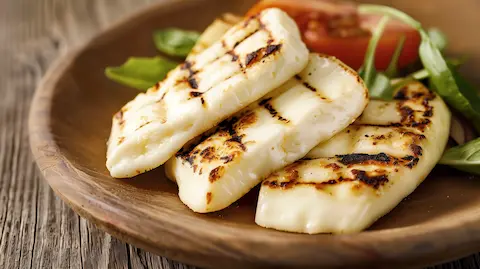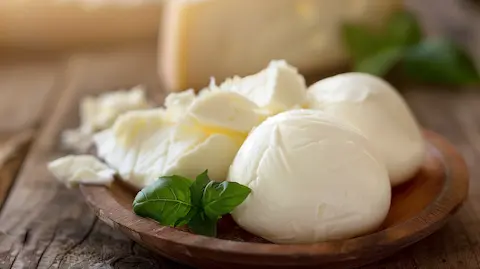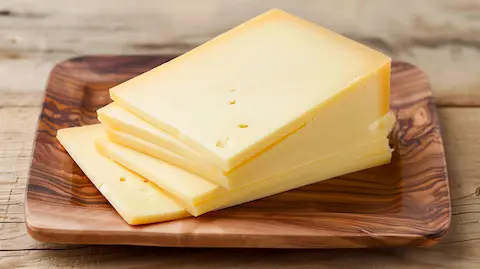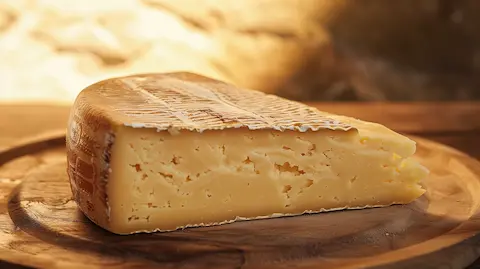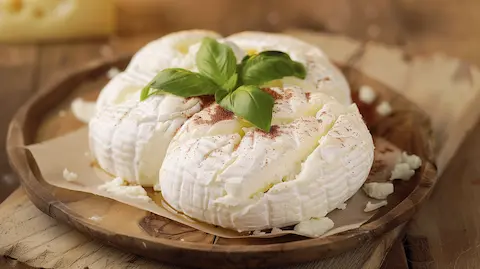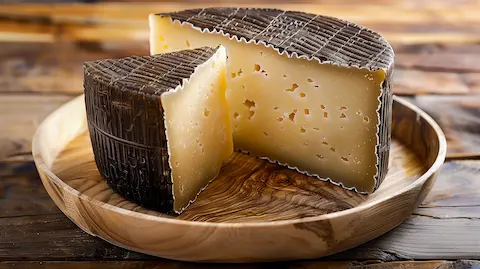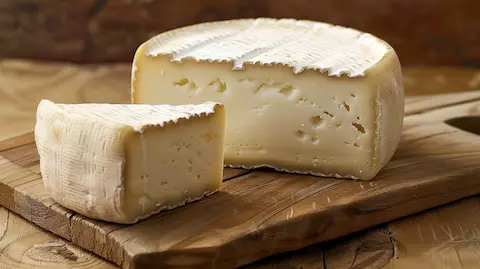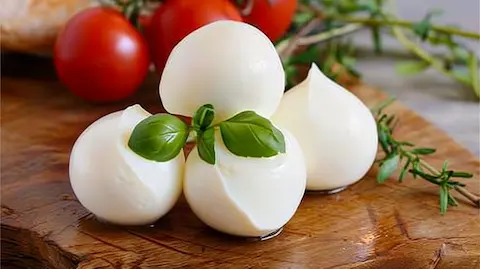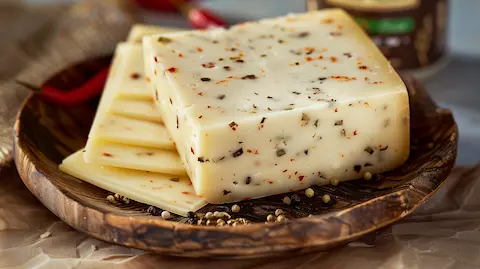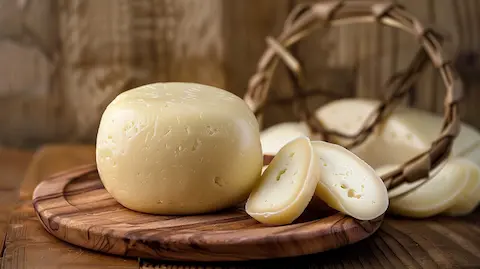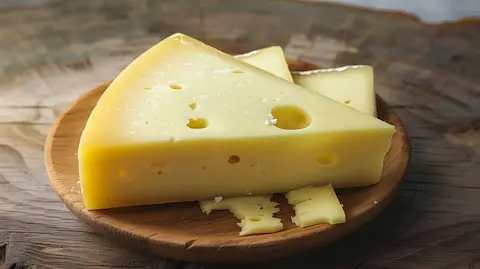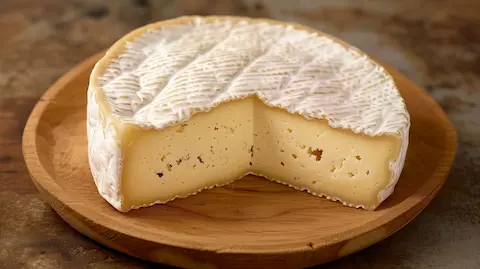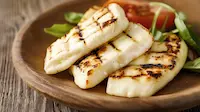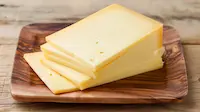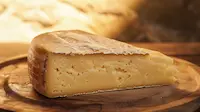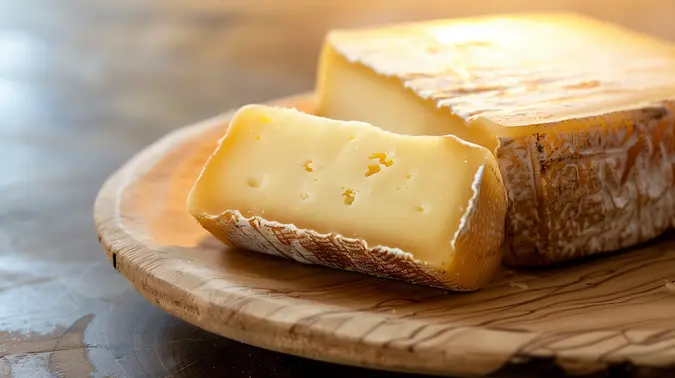Truffle Cheese
Truffle Cheese is a luxurious fusion of fine cheese and highly prized truffles, an underground fungus renowned for its intense aroma and deep, earthy flavor. This gourmet delight typically incorporates fragments of black or white truffles into its matrix, resulting in a rich and complex taste profile. Revered in culinary circles, truffle cheese varies from soft to semi-hard in texture and is often used to elevate dishes with its unique savoriness.
Next, let's explore how this sumptuous cheese is crafted to perfection.
How is Truffle Cheese Made?
Truffle Cheese is made by infusing high-quality cheese with slices or pieces of truffle during the cheese-making process. The base cheese, often a variety of soft or semi-hard cheese, is crafted using traditional cheese-making techniques. Pasteurized cultured sheep milk is warmed to the optimal temperature for the added cultures to ferment, creating the curd. Enzymes and salt are introduced to further develop the cheese's flavor and texture. Once the curd has reached the desired firmness, it is combined with finely chopped or shaved truffles. The mixture is then placed into molds, pressed, and aged for over 6 months, during which the truffle imparts its distinctive taste to the cheese. The aging process is carefully controlled to maintain the right humidity and temperature to ensure the cheese develops its characteristic sweet and earthy profile.
For a closer look at the production process, here is a detailed table:
Truffle Cheese Production Process
| Step | Ingredients | Method | Temperature | Duration |
|---|---|---|---|---|
| 1. Pasteurization | Pasteurized cultured sheep milk | Heat milk to eliminate bacteria and prepare for culturing | 161°F (72°C) | 15 seconds |
| 2. Culturing | Cultures | Add cultures to milk and allow fermentation | 90°F (32°C) | 1 hour |
| 3. Curdling | Enzymes | Add rennet to coagulate the milk into curds | 90°F (32°C) | 30 minutes |
| 4. Cutting & Cooking | Cut the curd and cook to expel whey | 100°F (38°C) | 30 minutes | |
| 5. Truffle Addition | Truffles | Mix in finely chopped or shaved truffles with curd | Room temperature | Varies |
| 6. Molding | Salt | Place curd and truffle mix into molds and press | Room temperature | 2-4 hours |
| 7. Aging | Age the cheese to develop flavor and texture | 50-55°F (10-13°C) | 6+ months |
What does Truffle Cheese taste like?
Truffle Cheese tastes like a harmonious blend of the rich, creamy base cheese with the distinct, aromatic qualities of truffles. The cheese itself is often sweet and buttery, providing a perfect backdrop for the truffles' deep, musky, and earthy notes. The intensity of the truffle flavor can vary depending on the type of truffle used and the duration of the aging process, but it typically imparts a luxurious and indulgent dimension to the cheese.
Truffle Cheese Profile
With a rich heritage and a distinctive flavor profile, Truffle Cheese is a gourmet's delight. Here are some key facts about this exquisite cheese:
- Made from: Pasteurized cultured sheep milk
- Country of origin: Influenced by Italian truffled cheese traditions
- Region: LaValle, WI
- Family: Infused cheese
- Type: Soft to semi-hard, depending on aging
- Texture: Creamy with truffle pieces
- Rind: Typically washed in truffle oil
- Colour: Varies from white to off-white with black truffle flecks
- Flavour: Sweet and earthy, with the distinct taste of truffles
- Aroma: Musky, with a deep, rich scent of truffle
- Vegetarian: Yes, often made without animal rennet
- Producers: Notable example includes Carr Valley Cheese Company
- Safe for dogs: Not recommended for canine consumption
- PDO status: Not applicable; however, it follows the tradition of Italian truffled cheeses
- Awards: Multiple accolades including 1st Place at the 2013 World Cheese Awards
Origin: Where does Truffle Cheese come from?
Truffle Cheese comes from a tradition of combining the rich flavors of cheese with the esteemed taste of truffles, a practice that has roots in Italian gastronomy. The art of infusing cheese with truffles has been refined over time, with producers around the world, such as the Carr Valley Cheese Company in Wisconsin, crafting their own versions of this decadent cheese. These cheesemakers draw inspiration from the Italian approach to truffle cheese, adapting the process to local tastes and milk sources.
How to Store Truffle Cheese?
Proper storage of Truffle Cheese is key to preserving its delicate flavor and texture. To maintain its quality, truffle cheese should be kept in the refrigerator, wrapped in parchment paper followed by a layer of aluminum foil to protect it from air and moisture. This method helps the cheese to breathe and prevents it from drying out or absorbing other flavors from the fridge.
- Initial Wrapping: Encase the Truffle Cheese in parchment paper.
- Secondary Layer: Add a layer of aluminum foil around the parchment paper.
- Refrigeration: Place the wrapped cheese in the least cold part of the refrigerator, typically the cheese drawer.
- Regular Checks: Inspect the cheese periodically for any signs of spoilage and to ensure the wrapping remains secure.
How long does Truffle Cheese last?
Truffle Cheese's shelf life depends on its storage conditions. When stored properly in the refrigerator, it can last for several weeks. Freezing is not recommended, as it can alter the texture and taste of the cheese, making it crumbly and less flavorful upon thawing.
| Storage Location | Shelf Life | Texture After Thawing | Taste After Thawing |
|---|---|---|---|
| Outside | 2 hours | ||
| Fridge | Up to 4 weeks | ||
| Freezer | Not recommended | Crumbly | Less flavorful |
Is Truffle Cheese pasteurized?
Yes, Truffle Cheese is made from pasteurized cultured sheep milk. Pasteurization is a process that heats the milk to a specific temperature to eliminate harmful bacteria, ensuring the cheese is safe for consumption while maintaining its rich flavor profile.
Can You Freeze Truffle Cheese?
No, freezing Truffle Cheese is not advisable. While freezing can extend the shelf life of many foods, it can significantly compromise the texture and flavor of Truffle Cheese. The delicate balance between the creamy cheese and the aromatic truffles is likely to be disrupted, resulting in a less enjoyable experience when thawed. The cheese may become crumbly and lose some of its rich, earthy truffle flavor that makes it so special.
How do you know if Truffle Cheese has gone bad?
To determine if Truffle Cheese has spoiled, look for signs such as an off smell, discoloration, or mold growth that wasn't present when the cheese was fresh. Eating moldy Truffle Cheese can lead to foodborne illness, especially if the mold is of a toxic variety. If you spot mold on a hard cheese, you can cut away the moldy part and consume the rest; however, soft cheeses like Truffle Cheese should be discarded entirely if mold is found, as the spores can spread throughout the cheese.
Alternatives to Truffle Cheese
While Truffle Cheese is a unique and luxurious choice for many, there are occasions when an alternative might be sought, whether due to availability, dietary restrictions, or personal taste preferences. Below are carefully selected substitutes that can mimic or replace the distinctive qualities of Truffle Cheese in various culinary applications.
Truffle Cheese Substitutes
| Cheese | Reason for Substitution | Flavor Profile | Texture | Best Used In |
|---|---|---|---|---|
| Brie with Truffle | Similar creamy base with truffle infusion | Rich, buttery, with subtle truffle notes | Soft, spreadable | Appetizers, cheese boards |
| Gouda with Truffles | Semi-hard alternative with truffle pieces | Sweet, nutty, with earthy truffle undertones | Semi-hard, sliceable | Sandwiches, grating over dishes |
| Herbed Goat Cheese | For those seeking a tangy flavor without truffles | Tangy, herbaceous | Soft, spreadable | Salads, spreads |
| Camembert | Truffle-free option, similar in creaminess and texture | Rich, buttery, with a hint of mushroom | Soft, slightly runny at room temperature | Baked dishes, cheese boards |
| Pecorino with Truffles | Hard cheese with truffle, for a sharper taste | Salty, sharp with truffle flavor | Hard, grateable | Pasta, risotto |
Truffle Cheese Popular Comparison
Brie with Truffle is often compared to Truffle Cheese for its similar creamy texture and the luxurious touch of truffle.
Truffle Cheese vs. Brie with Truffle
| Cheese | Origin | Milk Source | Texture | Flavor | Aging Time | Uses |
|---|---|---|---|---|---|---|
| Truffle Cheese | LaValle, WI | Sheep | Soft to semi-hard | Sweet and earthy with truffle | 6+ months | Elevating dishes, cheese boards |
| Brie with Truffle | Varies, often France | Cow | Soft | Rich, buttery with subtle truffle | 4-5 weeks | Appetizers, cheese boards |
WhatCheese invites you to explore the nutritional aspects of Truffle Cheese in the following section.
How to Use Truffle Cheese
Truffle Cheese shines as a culinary star, enhancing dishes with its unique flavor. When using this cheese, consider the intensity of the truffle aroma and the cheese's texture. For a soft Truffle Cheese, a cheese wire or a warm knife can create clean cuts without sticking. Semi-hard varieties can be sliced with a standard cheese knife. The key is to let the cheese come to room temperature before serving, to fully appreciate its complex flavors.
| Usage | Description |
|---|---|
| On a Cheeseboard | Pair with honey, nuts, and fruit for a balanced flavor experience. |
| As a Finishing Touch | Grate over pasta, risotto, or roasted vegetables to elevate the dish. |
| In Cooking | Melt into sauces or soups for added depth and richness. |
| With Wine | Pair with bold reds or sparkling wines to complement the truffle flavor. |
How to Serve Truffle Cheese
Serving Truffle Cheese at room temperature allows its flavors to fully express themselves. Present it on a cheeseboard with a cheese wire for soft varieties, ensuring a clean cut. For semi-hard types, a sharp cheese knife works best. Accompany with crusty bread, fruit preserves, and a selection of nuts to enhance the truffle's earthy notes.
Next, we will explore the nutritional profile of Truffle Cheese.
Recipes Using Truffle Cheese
Truffle Cheese's unique flavor makes it an excellent addition to a variety of recipes. Its luxurious taste elevates simple dishes and adds complexity to more intricate creations.
- Truffled Mac and Cheese: The creamy texture and earthy flavor of Truffle Cheese blend seamlessly into this classic comfort dish, providing a gourmet twist.
- Grilled Cheese with Truffle: Adding Truffle Cheese to grilled cheese sandwiches infuses a decadent truffle aroma into this beloved staple.
- Mushroom and Truffle Cheese Pizza: The cheese's earthy tones complement mushrooms perfectly, making for an indulgent pizza topping.
- Truffle Cheese Risotto: Stirred into risotto, Truffle Cheese melts beautifully, imparting its rich flavor throughout the creamy rice.
- Truffle Cheese Omelette: Whisked into eggs, it offers a sumptuous, savory note to start the day with a touch of luxury.
Next, we will scrutinize the nutritional data of Truffle Cheese.
Truffle Cheese Nutrition Data
When considering the nutritional value of Truffle Cheese, there are 312 calories in Truffle Cheese cheese per 100g. This gourmet cheese also provides a source of protein and calcium, making it a flavorful addition to a balanced diet. Below is a detailed breakdown of its nutritional content:
| Nutrient | Amount per 100g | Units |
|---|---|---|
| Calories | 312 | kcal |
| Total Fat | 25g | g |
| Saturated Fat | 17g | g |
| Cholesterol | 89mg | mg |
| Sodium | 621mg | mg |
| Total Carbohydrate | 3.1g | g |
| Dietary Fiber | 0g | g |
| Sugars | 0.2g | g |
| Protein | 21g | g |
| Calcium | 721mg | mg |
| Iron | 0.2mg | mg |
WhatCheese invites you to explore what's next in our journey through the world of cheese.
What's Next? WhatCheese Insights
As a connoisseur of cheese and a lifelong devotee to the art of cheesemaking, I've observed that Truffle Cheese has captured the hearts of gourmet enthusiasts worldwide. For those looking to indulge in this sumptuous cheese, specialty cheese shops and high-end grocers often carry a selection. I recommend seeking out cheesemongers who source from reputable producers, such as the award-winning Carr Valley Cheese Company. Their Black Truffle Sheep’s Milk cheese is a testament to the craftsmanship that goes into creating a cheese that's both rich in heritage and flavor.
For an immersive experience, consider attending cheese and wine tastings at renowned vineyards. These events offer the perfect opportunity to savor Truffle Cheese alongside expertly selected wines that highlight its complex profile. To ensure you don't miss out on these events, I've compiled a list of recurring gatherings that celebrate the fusion of cheese and truffle.
Upcoming Cheese and Truffle Events
| Event Name | Location | Date | Occurrence |
|---|---|---|---|
| Truffle Cheese Tasting Gala | Napa Valley, CA | September 5, 2023 | Yearly |
| Gourmet Cheese and Wine Evening | Charlottesville, VA | Monthly, First Friday | Monthly |
| Artisanal Cheese Fair | Madison, WI | June 12-14, 2023 | Yearly |
WhatCheese is here to guide you through the world of cheese, ensuring a delightful journey with every bite. Stay tuned for more insights and discoveries in the realm of cheese.
For those who appreciate Truffle Cheese's semi-hard texture and desire to explore similar cheeses, Gouda with Truffles offers a slightly firmer bite with sweet, nutty undertones complemented by the earthiness of truffles. Another excellent choice is Pecorino with Truffles, which provides a harder texture and a sharper, saltier flavor profile, perfect for grating over warm dishes.
Now, let's turn our attention to your questions about Truffle Cheese.

